The Leica M11 is the first new model in the M series in five years, replacing the numerous M10 variants with which it shares more than a passing resemblance. Like all the digital M-types before it, the M11 is evolutionary in scope but it is perhaps the most significant update yet.
The sensor is a full-frame 60 MP BSI CMOS type with what Leica calls ‘Triple Resolution Technology’ – offering three DNG raw data recording options – 60 MP, 36 MP, and 18 MP, respectively. In addition to the conventional 60 MP capture, the two lower-res options adopt pixel binning from the native resolution and are saved at the smaller image sizes. There’s also a new low base ISO sensitivity setting of ISO 64 and an upper limit of ISO 50,000. Continuous shooting maxes at 4.5 fps regardless of setting either RAW (DNG) or JPEG.
Besides the impressive pixel count, the Leica M11 is the first M-type model to adopt an electronic capture mode with a mechanical shutter. Shutter speeds max at 1/16,000 sec using the electronic option and run to 60 mins in B using the mechanical shutter. At the rear, the Leica M11 features a 2.95-inch (2.3m-dot) LCD touchscreen, a revised control layout, and a menu in line with the current Leica Q2 and SL2 models.
Further improvements over the outgoing M10 include a fixed baseplate with quick access to a new higher capacity battery and the SD UHS-II card slot. While it has just the one card slot, there’s a useful hardwired 64GB of memory just in case. Connectivity options include dual-band WLAN with the Leica Fotos app, and USB-C (with charging option). Bluetooth LE and GPS, again via the Leica Fotos app, are promised later in the year following a firmware update.
The Leica M11 is available now in chrome and a lighter-weight black model at $8995/8350€.
Key specifications
- 60.4 MP BSI CMOS sensor
- ISO 64-50,000
- 4.5 fps (RAW/JPEG)
- 0.73x optical rangefinder (EVF optional extra)
- 2.95-in 2.3 m-dot LCD touchscreen
- Single card slot (SD UHS-II) plus 64GB internal.
- WLAN (2.4/5GHz), USB-C
Overall performance
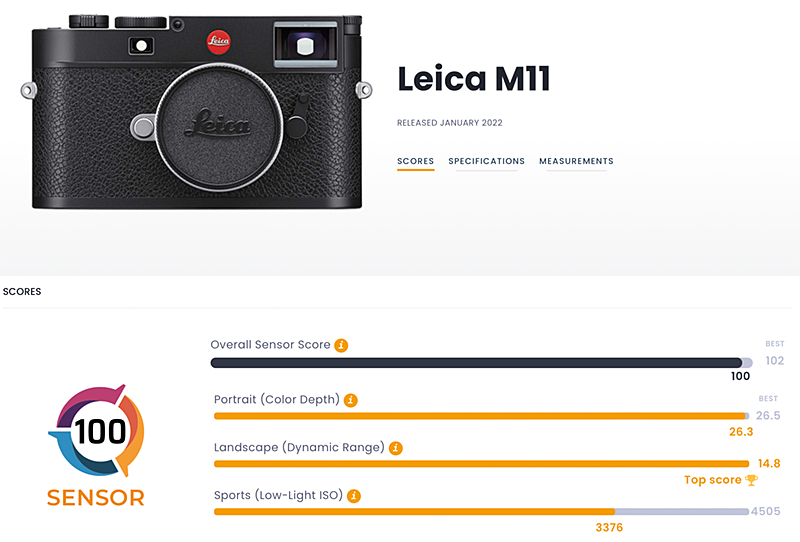 Click on the score chart above to open the Leica M11 product page.
Click on the score chart above to open the Leica M11 product page.
The 60 MP sensor in the Leica M11 achieved 100 in our benchmarks, indicating this is a state-of-the-art high pixel count full-frame 35mm format sensor. It ranks alongside the 45.7 MP Nikon D850 and 47 MP Panasonic Lumix S1R and is just fractionally behind the highest sensitivity sensors in our database, which are larger medium format types anyway. The Leica M11 is also 4 points higher than the Leica Q2 at 96, the last best performing Leica sensor we tested.
As for the individual metrics, the Leica M11 sensor exhibits a very high color depth at a low native base (ISO 64) of 26.3 bits. The new Leica M11 also has a high maximum dynamic range of nearly 15 stops (14.8 EV) at that same ISO setting. In the Sports (low-light ISO) category, which is a calculated figure based on specific minimum quality thresholds for noise (SNR), color depth, and dynamic range, the Leica M11 performed quite strongly at ISO 3361.
In-depth comparisons
The high price and rangefinder focusing means the Leica M11 occupies a rather niche space in the camera market sensor, however, it makes sense to compare it with the standard $6,895 (at launch) 24 MP Leica M10 variant it replaces. We’ve also pitted the new Leica M11 with the $3,499 Sony A7R IV for no other reason than the fact it has a similar 61 MP full-frame BSI type CMOS sensor.
Portrait (color depth)
The low base of ISO 64 helps the Leica M11 wring every last bit of color depth from the sensor, however, the difference is just +0.3-bit between that and the Sony A7R IV at base. Still, the two display a similar response throughout the sensitivity range albeit with a small boost in the latter’s curve from ISO 25,600 which mostly corresponds to its high-ISO expanded values.
When it comes to the Leica M10, there is a significant improvement, especially at low ISOs. At ISO 64 through ISO 800 for instance there’s a variance of around +1.5 bits over the older model. While that’s not surprising given the five years between them, it is indicative of the progress in sensor tech. Also interesting is the change regarding manufacturer ISOs. Where the M11’s measured ISO settings are just -0.2 EV lower than the manufacturer setting, the M10’s measured result is significantly lower at around -1 EV behind the stated value, from ISO 200 onwards anyway.
Landscape (dynamic range)
In this category, the curve showing the dynamic range of the Leica M11 is again practically identical to the response of the Sony A7R IV. In this instance, the Leica’s lower native base doesn’t leverage any advantage over the Sony at its true base of ISO100, with both reporting a maximum DR of 14.8 EV. And, while the Leica’s DR falls slightly at ISO 100, a dual gain boost at ISO 200 puts it back in contention with the Sony A7R IV.
What’s more striking of course is the improvement over the Leica M10. When comparing the two curves the newer M11 has more than a one-stop wider dynamic range throughout the sensitivity settings at the measured values. But, this narrows to around a +0.7 EV difference from ISO 400 and up at the manufacturers’ settings. This disparity when there is one is the reason why we show the measured results instead.
Sports (low-light ISO)
In this area where we calculate an ISO value that satisfies minimum quality standards of DR, SNR, and Color Depth, both the Leica M11 and Sony A7 R IV return practically the same result (ISO 3376 and 3344). The Leica M10 is less impressive in reaching the same thresholds at a significantly lower value of ISO 2133, which equates to being around -2/3 of stop noisier.
Conclusion
The Leica M11 is the most refined version of the digital M-type rangefinder models to date. Operation between the M-models and others has been unified and the sensor performance is at the leading edge, especially regarding dynamic range and color depth. Sure, it’s a pricey option for most people, but no one can say the Leica M11 is lacking in any way. Small and stealthy and with the black model now weighing less than its film siblings, the Leica M11 is going to appeal to a wide audience. Every practitioner of social documentary, street, portraiture, and landscape genres will want one.
In this review, we have mentioned the Leica M11’s most relevant rivals from other brands. As usual, you can compare it with these and with other models and create your own comparisons and in-depth analyses using our interactive image sensor ranking tool.


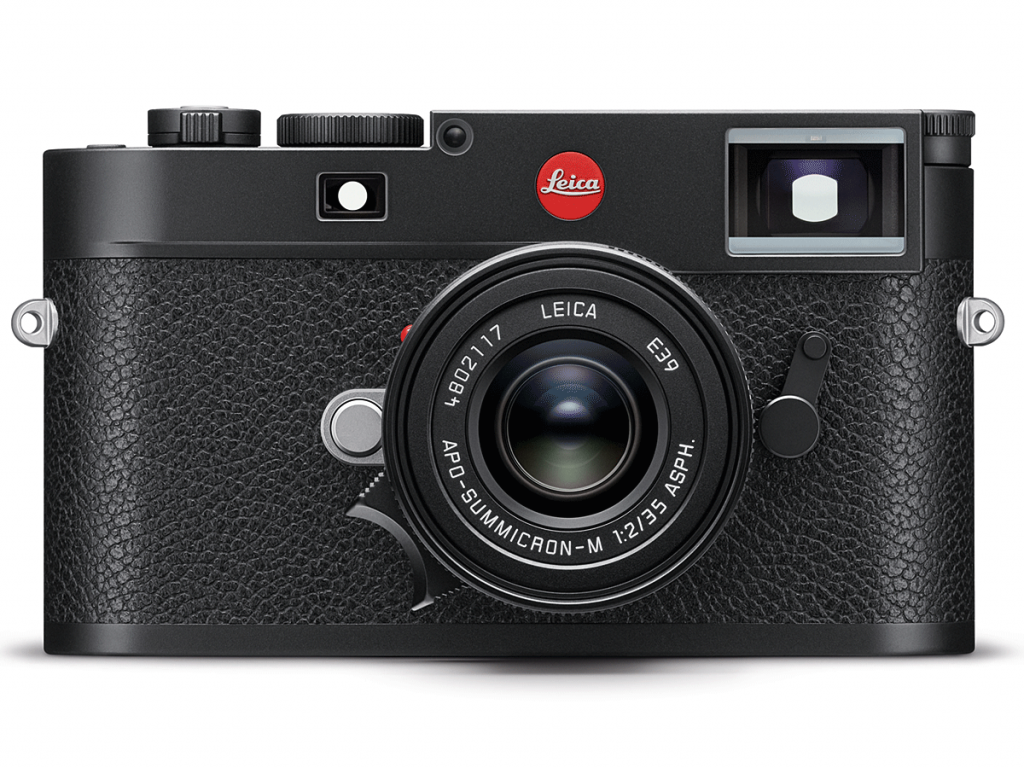


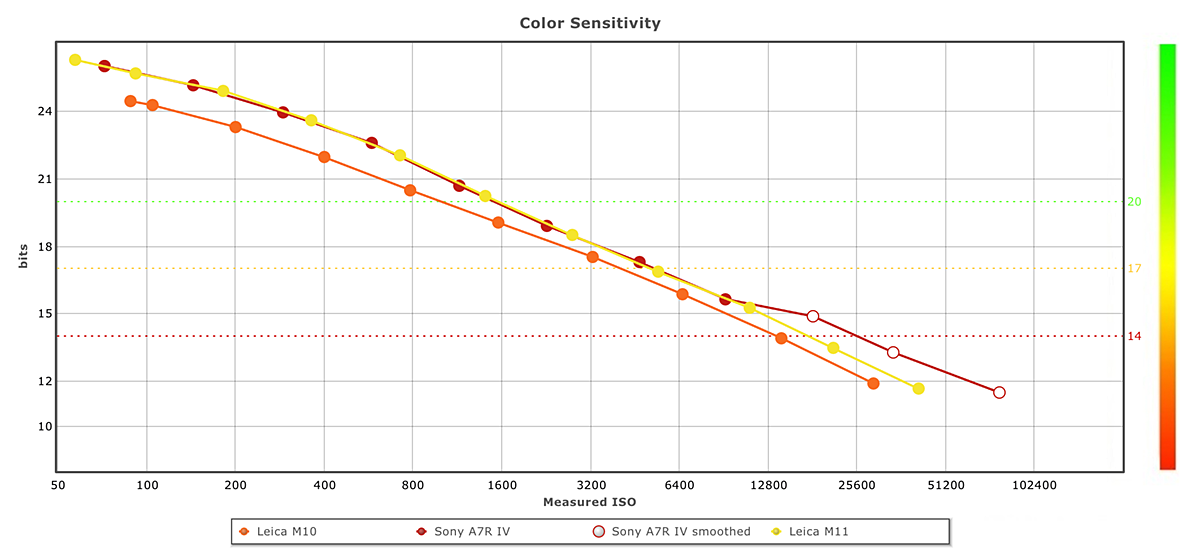
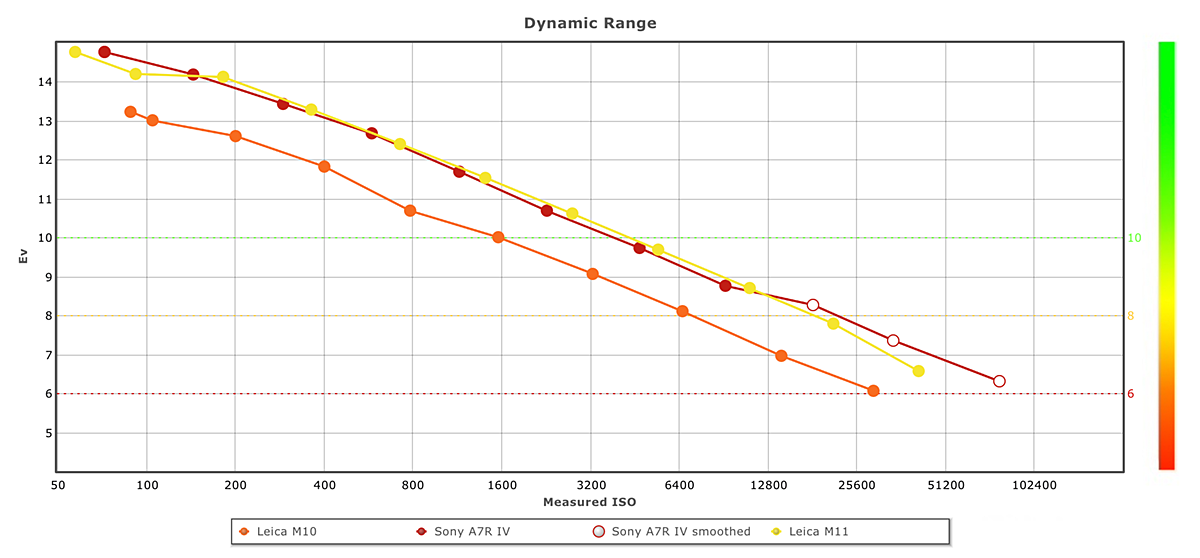
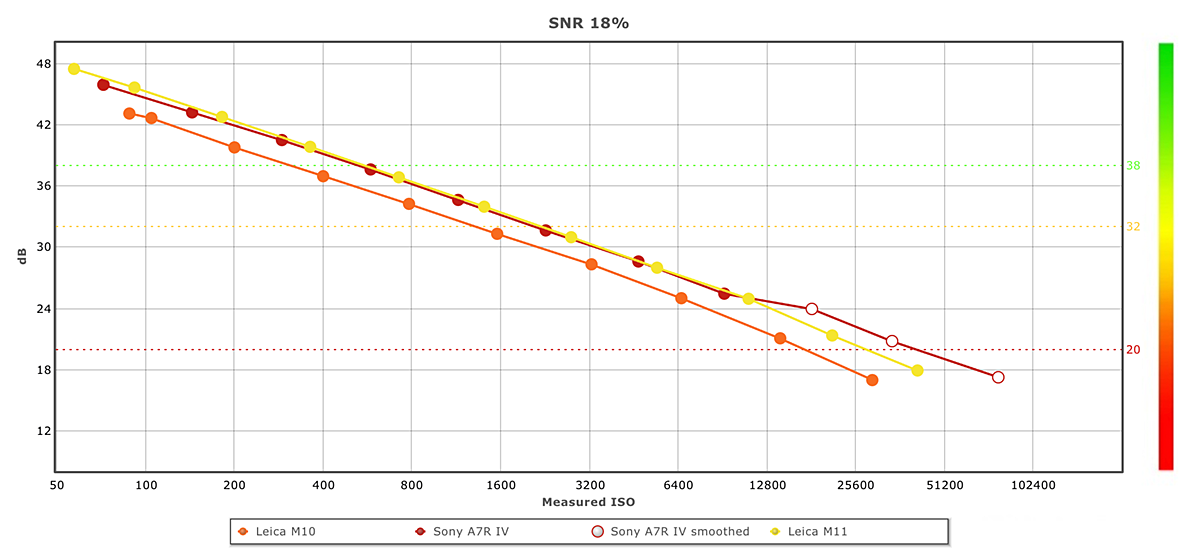
DXOMARK encourages its readers to share comments on the articles. To read or post comments, Disqus cookies are required. Change your Cookies Preferences and read more about our Comment Policy.